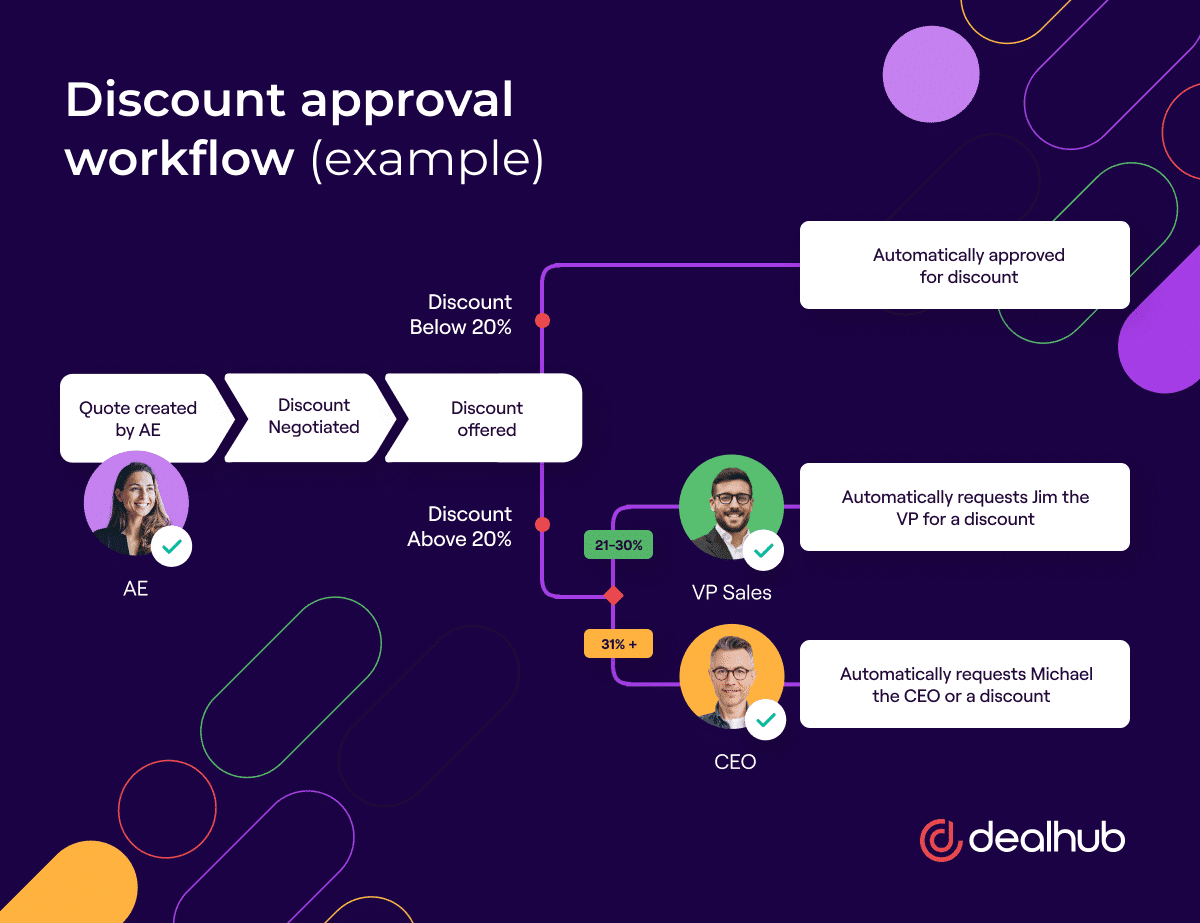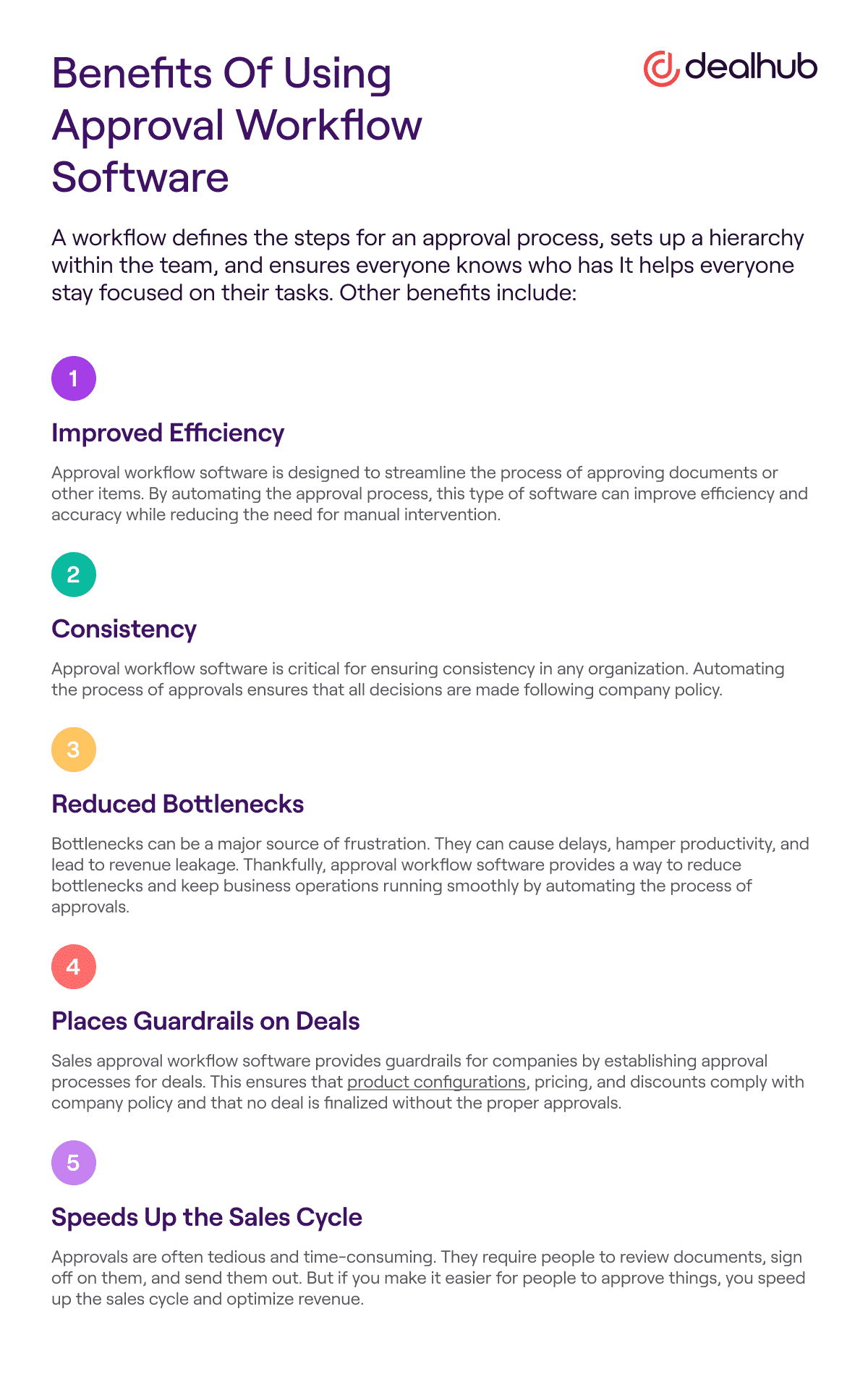Approval Workflows
Table of Contents
Table of Contents
What are Approval Workflows?
An approval workflow is a system that sends documents or items to the right people for approval or rejection. Setting up standardized approval steps automates communication, reducing delays and backlogs in the approval process.
Automating approvals can significantly enhance your sales and quoting workflows, helping your sales team close deals more quickly. Additionally, it minimizes revenue leakage, enforces accountability and timeliness, and improves communication across teams, making the entire process more efficient.
Synonyms
- Approval flow
- Approval process workflow
- Automated approvals
- Approval workflow engine
Types of Approval Workflows
Approval workflows in sales operations can keep internal communications moving along and speed up communication with deal stakeholders. Here are examples of the types of sales approval workflows that Sales Operations teams manage.
Discount approval workflow: To ensure that everyone is in agreement with a new contract when a customer requests discounting, a salesperson can initiate a discount approval workflow.
Sales quotation approval workflow: This workflow ensures that quotes are accurate, complete, and meet customer requirements. It may involve approvals from sales managers or other departments like finance for large deals.
Billing approval workflow: When billing adjustments are needed, this workflow minimizes errors and increases efficiency.
Legal or compliance approval workflow: Contract review and approval is a necessary part of the sales process to ensure all deals meet standard business requirements and regulatory policies.

How Approval Workflows Work in Sales Operations and CPQ
In sales operations, approval workflows play a critical role in ensuring pricing accuracy, compliance, and efficiency—especially when integrated with CPQ (Configure, Price, Quote) software. CPQ solutions automate the approval process by embedding predefined rules that dictate when and how approvals are required based on factors such as discount thresholds, contract terms, and deal complexity.
The approval workflow typically begins when a salesperson generates a quote or proposal within the CPQ system. If the pricing or configuration falls within standard parameters, the quote can be approved automatically, expediting the sales cycle. However, if a quote includes special pricing, custom terms, or large discounts, the software dynamically routes it to the appropriate approvers—such as sales managers, deal desk teams, legal, or finance—based on predefined approval rules.
Each approver can review, adjust, or approve the quote directly within the CPQ platform, with real-time notifications ensuring transparency and accountability at every stage. Advanced CPQ solutions also integrate AI-driven insights to suggest optimal pricing and discounting strategies, reducing unnecessary delays and maximizing deal value.
Elements of an Approval Process Workflow
Key components of an approval process workflow include the tasks, actions, approvers, permissions, timelines, notifications, and tracking:
- Tasks and Actions: What needs to be done and by whom?
- Approvers: Individuals responsible for approving.
- Permissions: Who has the authority to approve or reject?
- Timelines: Deadlines associated with each step.
- Notifications: Alerts sent to keep everyone informed.
- Tracking and Logging: Monitoring the progress and history of the workflow.
An approval workflow process follows a sequence of steps similar to these:
Step 1: Select a Workflow Type, Get Approval or Collect Feedback.
One example would be a salesperson who would like to approve a discount on a product for a client.
Step 2: Select a file to get approval
Select a file and then “Get Approval” from the Workflow menu, then reviewers can either approve, request edits, reject your file, or choose another option. Due dates allow you to track how long it takes to finish tasks. Add each additional reviewer by assigning them to your document.
Step 3: Necessary documents are sent to reviewers who will approve, reject, or hold for further discussion.
Step 4: The salesperson who initiated the workflow will receive email notification of the approval status and the next steps. In the case of a discount approval, the sales rep is free to move forward with the discount.
Common Approval Workflow Issues and How to Solve Them
Approval workflows are essential for maintaining efficiency and compliance, but several issues that cause delays, confusion, and errors. Below are some of the most frequent challenges businesses face in the approval process, along with how an automated approval workflow can help resolve them.
Unauthorized Document Changes
One major issue occurs when an approver modifies the document they are reviewing instead of simply approving or rejecting it. This can lead to inconsistencies, confusion, and unintended delays in approvals. Without proper version control, teams may end up working with outdated or incorrect information.
Solution: An automated approval workflow can enforce version control, preventing unauthorized edits while ensuring that all changes go through the appropriate review process.
Lack of Access to Approval Documents
Approvers sometimes struggle to access the documents they need due to security restrictions or incorrect permissions. This can stall the approval process and create frustration among team members.
Solution: A centralized approval flow with predefined access permissions ensures that the right stakeholders have secure, real-time access to the necessary documents, eliminating unnecessary roadblocks.
Approval Errors and Reversals
An approver may approve a document only to later realize they made a mistake—whether due to incorrect information, misinterpretation, or overlooking a crucial detail. Such errors can lead to compliance issues and require additional time to correct.
Solution: Implementing an automated approvals with validation checks and mandatory review steps can reduce human error. Additionally, approval logs help track decisions and provide a structured way to amend mistakes when necessary.
Missed Approval Notifications
Approvers may fail to receive timely notifications due to incorrect email addresses, spam filters, or notification system failures, leading to delays.Solution: Automated notifications ensure that approvers receive real-time alerts through multiple channels (email, in-app notifications, or SMS) to keep deals moving without unnecessary delays.
How to Select Approval Workflow Software
Automated approval workflows should integrate with the CRM platform you are already using, such as Salesforce or Microsoft Dynamics CRM.
Approval workflow tools should have the following features:
- Automated approvals alerts: Every enterprise can automate its approval processes by notifying the appropriate people when there’s a need for manual input or reviews.
- Code-free workflow applications: Leading workflow applications allow nontechnical users to automate aspects of their workflows, including filling out forms, scheduling tasks, and responding to email messages.
- Both online and offline access: Authorized employees can use cloud-based workflow software anywhere with an Internet connection, while offline access makes it easier for them to complete their tasks when they’re away from a networked computer.
- Distribution automation: Workflow software allows people to share documents with others by giving them access, permissions, and keeping track of changes.
- Signature collection: Workflow management applications can help streamline the process of collecting legally binding signatures on documents by automating signature capture and verification.
How to Design an Effective Approval Workflow
Designing a well-structured approval workflow is essential for ensuring efficiency, compliance, and accuracy in business processes. A streamlined approval flow reduces bottlenecks, minimizes manual errors, and accelerates decision-making.
Here’s how to create an effective approval process that meets your organization’s needs:
- Define Approval Criteria – Start by identifying the conditions that trigger an approval request. These may include pricing thresholds, discount levels, contract terms, or compliance requirements. Clearly defining approval rules ensures a seamless automated approval workflow that eliminates unnecessary delays.
- Identify Key Approvers – Determine who needs to approve different types of requests. This could include sales managers, finance teams, legal departments, or executives. Assigning the right approvers at each stage of the approval process ensures that decisions are made efficiently.
- Set Up an Automated Approval Workflow – Implement a system that routes approval requests based on predefined rules. A CPQ or workflow automation tool can ensure that approvals are sent to the appropriate stakeholders and processed in a timely manner. With an automated approval workflow, teams receive real-time notifications, and approvals can be granted with a single click, eliminating manual follow-ups.
- Establish Approval Flow Rules – Break down the workflow into a series of tasks and processes. Then, define the sequence of approvals and any dependencies between stages. For instance, quotes exceeding a certain discount threshold might require additional authorization from senior management. A well-structured approval flow prevents bottlenecks and ensures compliance with company policies.
- Integrate with Business Systems – Ensure your approval process connects seamlessly with your CRM, CPQ, ERP, or contract management systems. This integration provides visibility into approval status, maintains data consistency, and reduces administrative overhead.
- Monitor and Optimize – Continuously evaluate the effectiveness of your approval flow by tracking key performance metrics, such as approval turnaround time and bottlenecks. Leveraging analytics and AI-driven insights can help refine your automated approval workflow for even greater efficiency.
Designing a structured and automated approval workflow accelerates approvals, improves compliance, and enhances overall operational efficiency. This streamlined approach empowers teams to focus on high-value tasks instead of administrative burdens.
Benefits Of Using Approval Workflow Software
A workflow defines the steps for an approval process, sets up a hierarchy within the team, and ensures everyone knows who has It helps everyone stay focused on their tasks. Other benefits include:
Improved Efficiency
Approval workflow software, like Microsoft’s Power Automate, is designed to streamline the process of approving documents or other items. By automating the approval process, this type of software can improve efficiency and accuracy while reducing the need for manual intervention.
One of the benefits of using approval workflow software is that it can help to ensure that all necessary approvals are obtained promptly. This can be particularly important when deadlines need to be met or items need to be approved by multiple parties.
Another benefit of approval workflow software is that it can help to reduce the likelihood of errors. By automating the approval process, this type of software can help to ensure that all approvals are entered correctly and that no information is missed. This can help to save time and frustration when it comes to correcting errors.
Approval workflow automation can also help to improve communication between parties. This type of software can make it easier to track items’ status and ensure that all parties are aware of the latest developments by providing a central location for approvals. This can help to avoid misunderstandings and delays.
Consistency
Approval workflow software is critical for ensuring consistency in any organization. Automating the process of approvals ensures that all decisions are made following company policy. Approval workflow automation also eliminates the need for manual review and approval of documents, which can often lead to inconsistency.
Reduced Bottlenecks
Bottlenecks can be a major source of frustration. They can cause delays, hamper productivity, and lead to revenue leakage. Thankfully, approval workflow software provides a way to reduce bottlenecks and keep business operations running smoothly by automating the process of approvals. For example, the software can distribute requests to multiple approvers simultaneously rather than relying on a single person to approve every request.
In addition, you can customize approval workflow software to fit the specific needs of your business. For example, you can specify how many approvers are needed for each type of request and set up alerts to notify you when a request is waiting for approval. This level of customization ensures that your approval process is as efficient as possible.
Places Guardrails on Deals
Sales approval workflow software provides guardrails for companies by establishing approval processes for deals. This ensures that product configurations, pricing, and discounts comply with company policy and that no deal is finalized without the proper approvals. By automating sales approval workflows, companies can avoid costly mistakes and ensure all deals are vetted before being finalized.
Speeds Up the Sales Cycle
Approvals are often tedious and time-consuming. They require people to review documents, sign off on them, and send them out. But if you make it easier for people to approve things, you speed up the sales cycle and optimize revenue. An added benefit of a faster sales cycle is increased sales rep and customer satisfaction.

Take Your Deal Approval Workflows to the Next Level
A standardized, optimized, and efficient deal approval process for your business is vital in improving its productivity and optimizing revenue.
DealHub CPQ enables sales operations teams to easily implement deal approval workflows so all quotes and proposals adhere to company guidelines and quickly move through the sales cycle. The DealHub platform makes it easy to collaborate with stakeholders and ensures everyone stays on the same page. In addition, it saves time and effort by eliminating manual data entry and approval tracking. With an automated approval process, your sales reps can close deals faster.
People Also Ask
Why are approval workflows important?
There are many reasons why deal approval workflows are important. The primary reason is that they help to ensure that all deals are properly vetted and approved before being finalized. This helps to protect the company from any potential risks associated with a particular deal.
Another reason why deal approval workflows are so important is that they can help to streamline the entire process. By having a clear and well-defined workflow, all stakeholders involved in a deal will know exactly what needs to be done and when. This can help avoid any delays or confusion that could derail a deal.
Ultimately, deal approval workflows are vital because they maximize sales efficiency and accelerate revenue.
What is an approval workflow engine?
The approval workflow engine (AWE) is an application that provides the framework and capability for creating, running, or managing business processes. The engine uses a set of database objects combined with an application component setting to determine how to process approval requests using a workflow.
What are the differences between workflows and the approval process?
There are a few key differences between workflows and approval processes that are worth noting. For one, workflows often involve more than just approvals – they can also include tasks, notifications, and other automation steps. On the other hand, approval processes are only for managing approvals.
It’s worth noting that approval processes are often used in conjunction with workflows. In approval process automation, an approval process will be triggered by a workflow.



